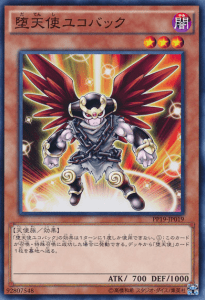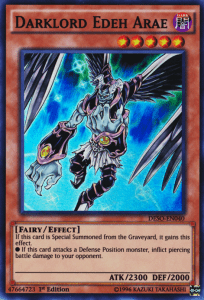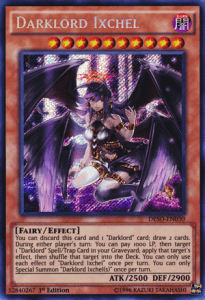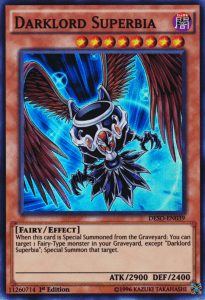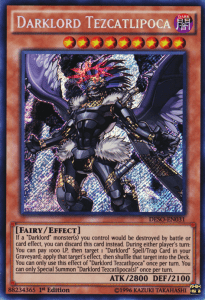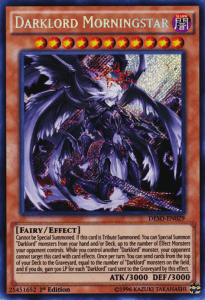This time around, we’ll be investigating the Darklords, the powerful DARK Fairy-Type monsters who first appeared with “Marie the Fallen One”.
To start off with, the Darklords are in Japanese called 堕天使 Datenshi, which is the exact Japanese term for Fallen Angels, as in the sort of angels who rebelled against God, led by Lucifer, and fell from heaven into the depths of hell as per Abrahamic lore. Yes, the Darklords are inspired as being members of the third of the Angels who sided with Lucifer in his rebellion against God, the Almighty, with least two cards from Destiny Soldiers supporting that some form of celestial rebellion occurs in the Yu-Gi-Oh! Card Game’s own personal lore.
But let’s first talk some history:
The first of the Darklords was “Darklord Marie“, who was originally dubbed “Marie the Fallen One“, first appearing in Labyrinth of Nightmare for the TCG (and Spell of Mask, one of the two sets used to make the TCG version of Labyrinth of Nightmare). At the time, she wasn’t anything significant in particular, other than a Fusion Material of the Fusion Monster, St. Joan, and was a portion of LP gain related cards from the latter half of the set (including cards such as Cure Mermaid, Dancing Fairy and even Fire Princess).
 The next real appearance of a Darklord would be “Darklord Nurse Reficule“, who first showed up as “Nurse Reficule the Fallen One“, from the Yu-Gi-Oh! GX animated series, used by the Duel Academy school nurse, Ayukawa Emi, dubbed in TCG territories as “Fonda Fontaine”. In the episode the card was used, it was used in a Bad Reaction to Simochi esque deck centering around Reficule instead of the epitomous trap, using cards such as Brutal Potion and Burning Algae to whittle down the LP of Yuki Judai (Jaden Yuki). The monster ultimately found itself printed as a promo card for the “Tag Force Evolution” Playstation 2 game.
The next real appearance of a Darklord would be “Darklord Nurse Reficule“, who first showed up as “Nurse Reficule the Fallen One“, from the Yu-Gi-Oh! GX animated series, used by the Duel Academy school nurse, Ayukawa Emi, dubbed in TCG territories as “Fonda Fontaine”. In the episode the card was used, it was used in a Bad Reaction to Simochi esque deck centering around Reficule instead of the epitomous trap, using cards such as Brutal Potion and Burning Algae to whittle down the LP of Yuki Judai (Jaden Yuki). The monster ultimately found itself printed as a promo card for the “Tag Force Evolution” Playstation 2 game.
So at this point the Darklords had established themselves in some vague form of LP manipulation, but much of the direction of the Darklords would change with two separate appearances in upcoming products.
The first would be the corrupt and twisted form of Archlord Zerato that was first released in the TCG release of Phantom Darkness: “Darklord Zerato“, without much connection to the previous two Darklords, it was more of a functional piece of the DARK Counterpart Deck that showed up in Phantom Darkness (using Rainbow Dark Dragon as the inspiration of this theme), serving as a Raigeki with legs.
But the real cards that established the theme would be the Darklords used by Hibiki Midori, a teacher and friend of Yuki Judai in the Yu-Gi-Oh! GX Manga. She only Dueled once in the Yu-Gi-Oh! GX manga, but this Duel established the Darklord identity that would be further reinforced in their return in Destiny Soldiers. Here she fought against Reggie MacKenzie of the American Duel Academy, showing off the foundation of the Deck for years to come: A High Level Fairy-Type Deck that specialized in reviving cards from the Graveyard to create an overwhelming field!
Finally, the Deck in 2016 was codified in a more refined form in Destiny Soldiers, expanding upon the Graveyard reliant tactics of the Darklords, but adding a new twist, paying LP to allow the latest Darklords to activate the effects of their own Spells and Traps from the Graveyard. And on top of that, the Deck could now search for Darklord cards (which resulted in the renaming of Marie and Nurse Reficule to Darklords in the TCG.)
Now with a history lesson over, let’s go into the Darklord’s naming scheme!
First, let’s start off with Nurse Reficule. This one is probably the easiest to explain and most likely to keep short: Its name is Lucifer spelled backwards, plus an E to make it a tiny bit less obvious. Lucifer being the obvious and most notorious of fallen angels, and their leader. As far as any lore goes here, there’s nothing much deeper for this card, other than ‘funny name’.
Next, Darklord Ukoback. Befitting his low level status, Ukoback refers to a low ranking demon in the infernal hierarchy charged with operating the boilers of hell, which ran on oil made from the blood of damned human souls. He first appears from the 1818 tome “Dictionnaire Infernal” (The Infernal Dictionary) by Jacques Albin Simon Collin de Plancy, a french occultist. The book in question was a collection of folklore and superstition the author collected during his youth.
Darklord Amdusc is next, a corruption of Amduscias, a demon noble described in the The Ars Goetia. The fact this monster looks more like a winged unicorn than a humanoid demon derives from the fact that Amdusc is described as having the head of a unicorn. In the lore of the Ars Goetia, he is a Great King of Hell, who commands 29 legions of demons. As well, he is associated with thunder (quite possibly connected to his extremely loud voice). As well due to the volume of his voice, he is associated with trumpets, and from there, he is capable of creating concerts and is said to be in charge of the music that echoes throughout Hell.
The Ars Goetia itself is a book of the Lesser Key of Solomon, published in the 17th century by an unknown author who compiled lore of centuries past, with the Ars Goetia itself mostly derived from Johann Weyer’s Psuedomanarchia Daemonum (The False Hierarchy of Demons), an appendix of his De prestigilis daemonum (“On the Tricks of Demons”). “On the Tricks of Demons” was itself chiefly meant not to encourage people to practice the diabolic arts, but rather expose and mock any who dare call themselves magicians or mages, as Weyer believed that most witchcraft and sorcery was not a compact of the devil, but delusions of grandeur.
Darklord Edeh Arae is an interesting case. First off, Arae is a corruption of the Latin “Alae”, which means wings. Edeh itself is a unclear, as it could come from “Ede”, Latin for ‘to eat’. Or a corruption of Eden, the garden of heavenly delights created by God. Or perhaps it is Edel, German for Noble Wings. So it could mean “Gluttonous Wing, Wings of Paradise, or Noble Wing”. The other implication is Arae might be a corruption / similar sound to Ira, “Anger/Wrath”, one of the Seven Deadly Sins, to go with Asmodeus being Lust and Superbia being Pride.
Following up is Asmodeus, a famous demon in many circles of demonology. Most notably is Asmodeus being the demon lord associated with the Deadly Sin of Lust. His first appearance is in The Book of Tobit where he serves as the chief antagonist, murdering the husbands of a woman named Sarah soon after marrying them. Here he is ultimately defeated by Tobias, Sarah’s cousin, working in tandem with the Angel Raphael, by burning the guts of a fish, a smell that drives Asmodeus into Upper Egypt where Raphael binds and seals him away.
Much debate over his name’s origin exists, but it is chiefly speculated to derive from Aesma and Daeva, Avestan for “Wrath” and “Demon/Divine Being”, so “Demon of Wrath”, which befits his abusive and stalking nature in The Book of Tobit. His other major appearance is in The lesser Key of Solomon, where he is described as being a three-headed demon with the head of a bull, a man and a ram who rides a dragon, reigning over 72 legions of spirits and demons. Needless to say his appearance in Yu-Gi-Oh! has nothing to do with the Ars Goetia, instead favoring that of a tall and muscular but otherwise non-descriptive Demon.
Darklord Ixchel is up next, and she’s a double doozy, as she has a name difference between the OCG and the TCG:
Ixchel herself is an old (as in like grandmother age) Jaguar goddess from the Mayans who presided over midewifery and medicene. Despite her age, she was heavily seen as a source of gurantee for a happy marriage and contraception. Conceptually she appears to have been a crone goddess representing the Moon waning. And with the barren-ness of old age, Ixchel would have been the goddess to help guarantee a safe birth and the health of the family even if she could not provide children.
However, Darklord Ixchel in Japan is known as Fallen Angel Ixtab. Ixtab was a goddess from the Yucatec society, who had domain over suicide. In that culture, forms of suicide such as hanging by rope were considered a way of honor. Specifically, Ixtab served as a psychopomp for honorable suicides to the Mayan version of paradise. The honorable suicides were given guarantees of good food, drink and rest alongside those such as priests, soldiers, mothers who died in childbirth and those who served as sacrifices for the Gods.
But either way, neither entity seems to line up with Ixchel the Darklord who appears to be something more of a succubus or seductress, than anything else.
Next on our list is Darklord Superbia, the monster that formed much of the core of the Darklord’s resurrection strategy: This one is simple. It’s named after the Latin word “Superbia”, which means pride or arrogance. And Pride is the biggest of the Seven Deadly Sins, and suggested to be the root of the other Deadly Sins.
Next up is Darklord Zerato, who. Honestly likely a made up name that is a product of fiction, rather than any origin in history. The most possible original is Warrior of Zera and Zera the Mant‘s Zera means “Descendant” in Hebrew but I suspect this is incidental, rather than intentional.
Darklord Desire is a fairly obvious one. It’s named after desire, as in want, which is considered the basis for the sins of Lust, Envy and Greed, which would make sense with the generalized Seven Deadly Sins related cards Midori ran in the GX manga. However, there’s not much else to say here.
Next up is Darklord Tezcatlipoca, another South American themed Darklord. Unlike Ixchel/Ixtab, Tezcatlipoca derives from the Aztec civilization. The name Tezcatlipoca means “Smoking Mirror”, related to the fact that Mesoamerica mirrors were often forged from obsidian, and were associated with rituals and prophecies performed by shamans. Of interest, very few images remain of Tezcatlipoca from the Spanish massacre of the Mesoamericas, resulting in him being dubbed ‘invisible’. However it is noted black is heavily associated with him, befitting his connection to the mirrors of lore. As well, Tezcatlipoca was a major rival god to the Quetzacoatl.
Indication of his personality, he seems to fit the role of the classic trickster/chaos bringer archetype that reappears in myths throughout the world (making him somewhat similar to Coyote and Loki). As to his actual domains he is associated with a wide variety of influences, such as the weather at night, obsidian, disasters, prophecy and magic, and leadership. Ultimately a fair number points to him being seen as the all important influence of disaster and disorder causing things to change, for better or worse.
One of the more classic myths is he and his brother conflicted over multiple iterations of the World, with Tez himself ruling the first world, the World of the Black Sun which was inhabited giants. Until his brother destroyed it, causing Tez to turn into a Jaguar in a fit of rage and consume the world to force things start over. After several other worlds failing failed, he worked with his fellow Gods to create a collaborate world that is the Fifth Sun, our present world.
Now as to why he became a Darklord? Likely the Spanish and the Catholic Church demonizing Tezcatlipoca in their violent conversion of Mesoamerica to the faith of Christanity, labelling him an especially dangerous demon. So he’s a fallen god (i.e. angel) by proxy.
Darklord Nasten was originally named Fallen Angel Mastema. Mastema is an angel who deals out punishment according to Jewish lore and is mentioned in the Book of Jubilees. His name means “Hatred” or “Hostlity” in Hebrew. Simply put, Mastem is the Satan of the Old Testament, an angel who serves as the dealer of punishments of God throughout the Old Testament (unleashing the plagues on Egypt, inflicting the punishments upon Job, and suggest god test Abraham.). Likely because Mastema is associated with the Satan of the Old Testament, that his name ended up being changed to something much more mundane as to avoid controversy. (Now how we got Asmodeus past the radar is another kettle of fish worth asking.)
His English name derives from a frankly unknown king from the area of Afghanistan-Iran. Basically nothing is known that he exists, other then he is the son of “Xatran”. So what reasons the TCG named him that way, other than to get away from the implications that this monster is an alternate form of the Devil, remain unknown.
Finally, the big boss of the Darklords, Darklord Morningstar. To start with, in Japan, he’s called Fallen Angel Lucifer. Yes. That Lucifer. Lucifer itself is interesting, it was originally the 4th century Vulgate bible translation of the word Heylel, which meant “Bringer of Dawn”/”Morning Star”. Which was a common title for the planet Venus. The connotation of Lucifer itself being the Devil’s true name is a more modern invention. The interesting point is the source line from the Bible, Isaiah 14:12, is that Lucifer as described, was not the devil, but a title given to a Babylonian ruler(s). Regardless of this, it’s ended up becoming connected to the Devil. (Most likely because of the James King Bible)
Now, Lucifer the Fallen Angel, is essentially in common lore, as depicted in the Darklord cards, as being an Angel (often God’s highest ranking angel before his exile) who turned on God for reasons unknown (the actual Bible is fairly sparse on WHY he turned on God and fell, and frankly there’s little indication he did, as Isaiah 14:12 doesn’t refer to Satan, but a Babylonian King). But based on that common lore, Darklord Rebellion is him turning on Yu-Gi-Oh!’s version of The Lord Almighty, with Banishment of the Darklords representing their being cast out from Heaven.
That said, his English name is literally the English translation of the Latin word “Lucifer”.
Anyways, that’s it for the Darklords. I hope people learned something from all this with their favorite DARK Fairy-Type Deck!
If I manage to find time, I’ll probably go after Fusion Enforcer’s Invoked series, centered around Aleister the Invoker, next!

![[What’s In A Name] The Darklords](https://cdn.ygorganization.com/2016/12/DarklordDesire-TF04-JP-VG.png)

